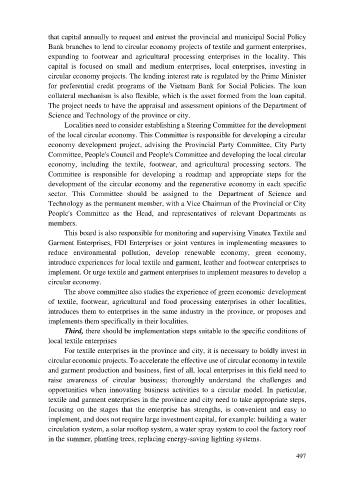Page 505 - Ebook HTKH 2024
P. 505
that capital annually to request and entrust the provincial and municipal Social Policy
Bank branches to lend to circular economy projects of textile and garment enterprises,
expanding to footwear and agricultural processing enterprises in the locality. This
capital is focused on small and medium enterprises, local enterprises, investing in
circular economy projects. The lending interest rate is regulated by the Prime Minister
for preferential credit programs of the Vietnam Bank for Social Policies. The loan
collateral mechanism is also flexible, which is the asset formed from the loan capital.
The project needs to have the appraisal and assessment opinions of the Department of
Science and Technology of the province or city.
Localities need to consider establishing a Steering Committee for the development
of the local circular economy. This Committee is responsible for developing a circular
economy development project, advising the Provincial Party Committee, City Party
Committee, People's Council and People's Committee and developing the local circular
economy, including the textile, footwear, and agricultural processing sectors. The
Committee is responsible for developing a roadmap and appropriate steps for the
development of the circular economy and the regenerative economy in each specific
sector. This Committee should be assigned to the Department of Science and
Technology as the permanent member, with a Vice Chairman of the Provincial or City
People's Committee as the Head, and representatives of relevant Departments as
members.
This board is also responsible for monitoring and supervising Vinatex Textile and
Garment Enterprises, FDI Enterprises or joint ventures in implementing measures to
reduce environmental pollution, develop renewable economy, green economy,
introduce experiences for local textile and garment, leather and footwear enterprises to
implement. Or urge textile and garment enterprises to implement measures to develop a
circular economy.
The above committee also studies the experience of green economic development
of textile, footwear, agricultural and food processing enterprises in other localities,
introduces them to enterprises in the same industry in the province, or proposes and
implements them specifically in their localities.
Third, there should be implementation steps suitable to the specific conditions of
local textile enterprises
For textile enterprises in the province and city, it is necessary to boldly invest in
circular economic projects. To accelerate the effective use of circular economy in textile
and garment production and business, first of all, local enterprises in this field need to
raise awareness of circular business; thoroughly understand the challenges and
opportunities when innovating business activities to a circular model. In particular,
textile and garment enterprises in the province and city need to take appropriate steps,
focusing on the stages that the enterprise has strengths, is convenient and easy to
implement, and does not require large investment capital, for example: building a water
circulation system, a solar rooftop system, a water spray system to cool the factory roof
in the summer, planting trees, replacing energy-saving lighting systems.
497

